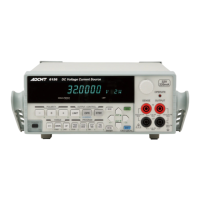6146/6156 DC Voltage/Current Generators Operation Manual
6. PERFORMANCE TEST
6-1
6. PERFORMANCE TEST
This chapter describes the methods for checking whether the 6146/6156 operates in the specified accuracy.
6.1 Measuring Instruments Necessary for Performance Test
Use a measuring instrument for the performance test which meets the specifications shown in Table 7-1,
"Accuracies and Cables Necessary for Calibration."
6.2 Connections
The connections required for the performance test are the same as shown in Figure 7-1, "Connections for Cal-
ibration."
6.3 Test Method
Execute the performance test under the following conditions in a location free of dust, vibration, noise or
other adverse conditions:
Temperature: 23 ± 5°C
Relative humidity: 70% or lower
Warm-up: 30 minutes or longer
• Self-test, display, key, and buzzer tests
1. Select MENU and SYS and refer to Section 4.2.12, "Self Test" to execute.
NOTE: If an error occurs during the test, refer to Section 4.2.12, "Self Test" to verify
the content of the error.
• Voltage source/limiter test
1. Connect the 6146/6156 and DMM (Digital Multimeter) as shown in Figure 7-1
(a).
2. Set DMM to DCV, auto range and integration time of 10 PLC or longer.
3. Set the 6146/6156 to the DC source mode.
4. Select voltage source.
With ZERO and ± Full Scale generated in the 300 mV range to 30 V range, verify
that the difference between the source value and the DMM measured value is
within the accuracy described in Chapter 8, "SPECIFICATIONS."
5. Select current source and set to the 3 mA range.
With ZERO (minimum value: 1 V) and ± Full Scale of the voltage limit set, verify
that the difference between the setting value and the DMM measured value is
within the accuracy described in Chapter 8, "SPECIFICATIONS."

